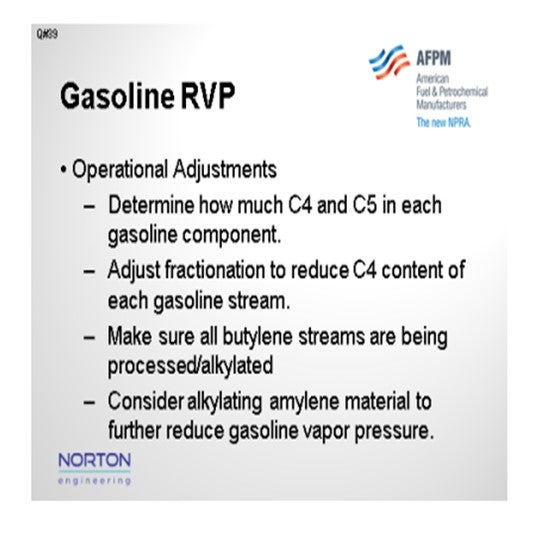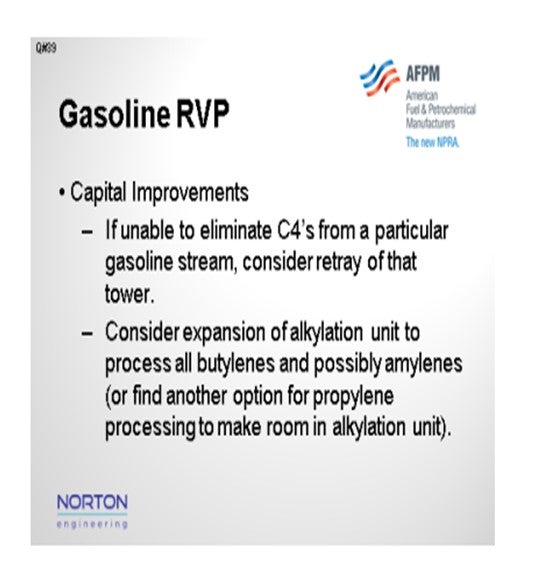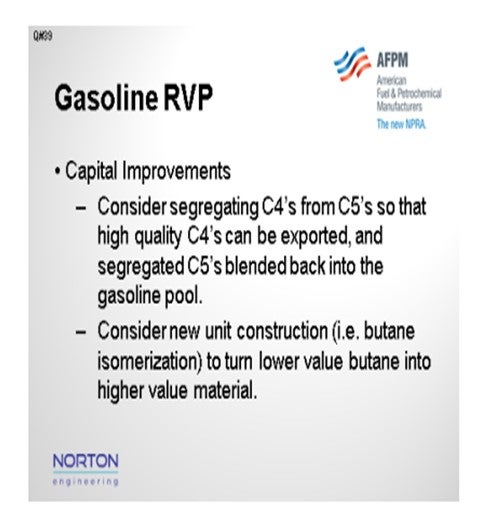Question 39: What options are available for managing blend stream Reid Vapor Pressure (RVP) and pentane content during the summer blend season? Discuss operational changes in existing equipment, simple modifications, and large capital projects.
STEVES (Norton Engineering Consultants, Inc.)
Each refinery configuration will obviously be very different, so there is never going to be a one-size-fits-all solution for managing gasoline component RVP or dealing with pentane streams. However, there are certainly many common elements that can be explored. First of all, it is important to understand the light-end C4s and C5s present in each of the gasoline components in your refinery. Next, try adjusting fractionation to reduce the C4 content of each gasoline component stream. Fully debutanizing these streams will make it much easier to optimize blending to ensure that the finished product will meet the required vapor pressure specifications.
Refiners should also consider whether all butane streams that can be refined to produce gasoline are being effectively handled. For instance, are all of your butylene molecules being alkylated to produce gasoline, or are some of those butylene molecules ending up in your gasoline pool and increasing the RVP? In addition to making sure that all available butylene streams are being refined through alkylation or polymerization, for instance, a refiner may also consider alkylating some of the amylenes that exist in the gasoline pool.

After evaluating each of the operational changes possible to reduce the gasoline stream RVP, it may become apparent that capital investment is required. If a particular gas stream cannot be fully debutanized, the refiner should consider re-traying that tower to improve its performance for removing all C4s. Similarly, if extra capacity is not available in the alkylation unit to alkylate all of the butylenes, or if amylene alkylation is desired, then expansion of the alkylation unit may need to be explored; or you may consider looking at other processing options for the propylene to make room for those streams in the alkylation unit.

In addition to segregating and separating the butane streams from each gasoline component, it can also help to segregate the pentanes from the butanes and put those pentanes in dedicated storage. Segregation of the pentanes from the butanes will allow high quality butanes to be exported for storage or sold as feedstocks to other refiners and the segregated pentane to be blended back into the gasoline pool. A mixed butane and pentane stream is going to be much harder to get rid of.
Finally, construction of a new unit can also help reduce the quantity of butanes that have to either be exported or blended into the gasoline pool. It will obviously cost a lot of money. Construction of a butane isomerization unit, for instance, will reduce the quantity of butane that needs to be exported or blended and create a nice isobutane stream which can be used to reduce or eliminate isobutane imports needed for an alkylation unit.
